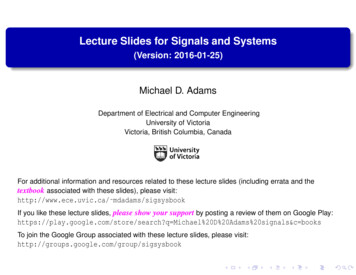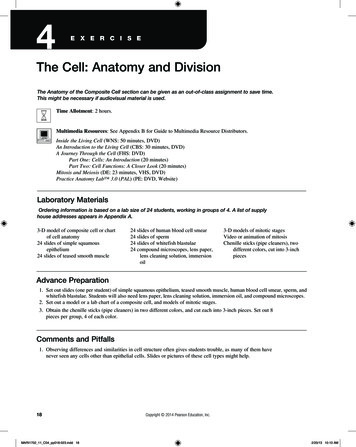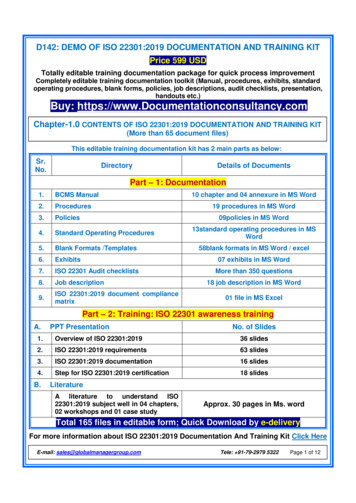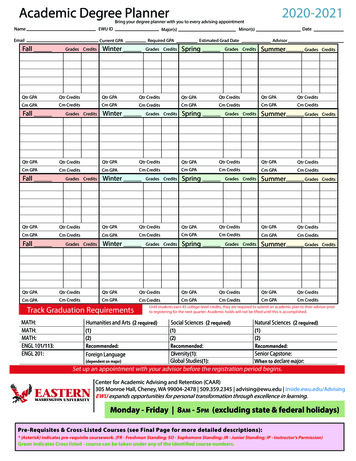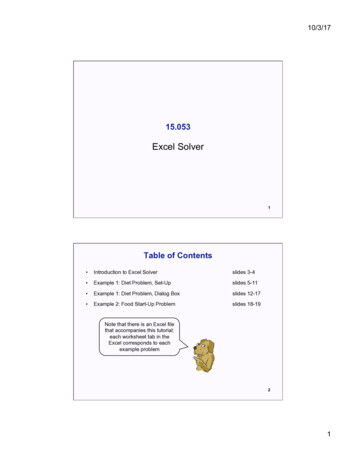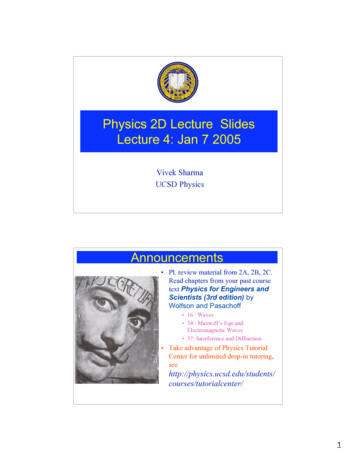
Transcription
Physics 2D Lecture SlidesLecture 4: Jan 7 2005Vivek SharmaUCSD PhysicsAnnouncements Pl. review material from 2A, 2B, 2C.Read chapters from your past coursetext Physics for Engineers andScientists (3rd edition) byWolfson and Pasachoff 16 : Waves 34 : Maxwell’s Eqn andElectromagnetic Waves 37: Interference and Diffraction Take advantage of Physics TutorialCenter for unlimited drop-in es/tutorialcenter/1
Einstein’s Special Theory of RelativityEinstein’s PostulatesThe laws of physics must be the same inall inertial reference framesThe speed of light in vacuum has thesame value c 3.0 x 108 m/s ) , in allinertial frames, regardless of the velocityof the observer or the velocity of thesource emitting the lightConsequences of Special Relativity: Simultaneity not AbsoluteSimultaneity: When two events occur at same time, held absolute for Classical PhysLightning boltsEvents that are simultaneous for one Observer arenot simultaneous for another Observer in relative motionSimultaneity is not absolute !!Time interval depends on the Reference frame it is measured in2
A Simple Clock Measuring a Time Intervalt " !tOne hour 60 x 1 minute time intervalsTime Dilation and Proper TimeWatching a time interval (between 2 events) with a simple clock2dcObserver O : Apply Pythogoras TheoremObserver O' : "t ' 222# c"t # v"t # c"t ' %& (d ) %& , but d %&' 2 (' 2 (' 2 ()c 2 ("t ) c 2 ("t ' ) v 2 ("t ))"t 22"t '#v 1* % &'c(22 ! "t ', "t "t '3
γ11 # v2 / c2as v " 0, ! " 1as v " c , ! " Speed of light barriereThrotcfa! Pop Quiz !SamSallyv What happens when I reverse the clocks being watched ?– Sally now watches Sam’s clock– Sally is moving w.r.t. Sam’s clock. Sam is at rest w.r.t the clock.– What does she make of time intervals as measured by his clock ?4
Measuring Time: Period of a Pendulum Period of a pendulum is 3.0 s in the rest frame of the pendulum What is period of the pendulum as seen by an observer moving at v 0.95cAnswer: Proper time T’ 3.0s Since motion is relative and time dilation does not distinguish between relative motion (V) from relative motion (-V) lets reformulate the problem like this (?) A pendulum in a rocket is flying with velocity V 0.95c past a stationary observer Moving clocks runs slower [w.r.t clock in observer’s hand (rest)] by factor γ Period T measured by observer γ T’! 11 (v / c )2 11 (0.95) 2 3.2" T ! T ' 3.2 # 3.0 s 9.6 sMoving pendulum slows down takes longer to complete a periodAll Measures of Time Slow down from a Moving Observer’s Perspective ! Your heartbeat or your pulserate Mitosis and Biological growthGrowth of an inorganic crystal‘.Watching the river flow’’ all measures of time interval5
Round The World With An Atomic Clock ! Atomic Clock : measure timeinterval for certain atomic leveltransitions in Cesium atom Two planes take off from DC, traveleast and west with the atomic clock– Eastward trip took 41.2 hrs– Westward trip took 48.6 Atomic clocks compared to similarones kept in DC Need to account for Earth’s rotation GR etcTravelPredictedMeasuredEastward-40 23 ns-59 10 nsWestward275 21 ns273 7 nsFlying clock ticked faster or slower than reference clock. Slow or fast is due toEarth’s rotationCosmic Rain ! Cosmic “rays” are messengers from space Produced in violent collisions in the cosmosTypical Kinetic energy 100 GeVSmash into Earth’s outer atmosphere 4700 m from sea levelSometimes produce short lived Muons (µ) Muon is electron like charged particle 200 times heavier , same charge Lifetime τ 2.2µs 2.2 x10-6 s Produced with speed v c Distance traveled in its lifetimed c! 650m Yet they seem to reach the surface!! Why Time Dilation Must pay attention to frames ofreferences involved6
Cosmic Rays Are Falling On Earth : Example of Time Dilation τConsider Two frames of references1. You Riding on the Muon Particle2. Your twin watching On surface of earths–Muon Rider has “Proper Time”–Interactionτ’Time measured by observer movingalong with clock– Δt’ τ 2.2 µSτ– D’ v Δt’ 650m–Earthling watches a movingclock (muon’s) run slower– Δt’ γ τ– v 0.99c, γ 7.1Sea Level– D v Δt 4700mMuon Decay Distance DistributionRelative to Observer on Earth Muons have a lifetimet γτ 7.1 τExponential Decay time Distribution : As in Radioactivity7
Offsetting Penalty : Length ContractionStar AStar BL Δt’ . V!VObserver OObserver OΔt’Δt L’/VObserver O’At rest w.r.t stars A & BWatches rocketship cross fromStar A to Star B in time ΔtRocketman Vs The Earthling Earth Observer sawrocketman take time Δt (L’/V) Rocketman says he is at rest,Star B moving towards himwith speed V from rightpassed him by in time Δt’, soL’Proper Length– L Δt’. V– But Δt’ Δt / γ (time dilation)– L V. (Δt/ γ ) L’/γL L'. 1- Vc2L ! L'2Some LengthMoving Rods Contract in directionOf relative motion8
Perspectives Change Along Direction of MotionPerspectives Change9
Immediate Consequences of Einstein’s Postulates: Recap Events that are simultaneous for one Observer are notsimultaneous for another Observer in relative motion Time Dilation : Clocks in motion relative to an Observerappear to slow down by factor γ Length Contraction : Lengths of Objects in motionappear to be contracted in the direction of motion byfactor γ –1 New Definitions :– Proper Time (who measures this ?)– Proper Length (who measures this ?)– Different clocks for different folks !Doppler Effect In Sound : Reminder from 2AObserved Frequency of sound INCREASES if emitter moves towards the ObserverObserved Wavelength of sound DECREASES if emitter moves towards the Observerv fλ10
Time Dilation Example: Relativistic Doppler Shift Light : velocity c f λ, f 1/T A source of light S at rest Observer S’approches S withvelocity v S’ measures f’ or λ’, c f’λ’ Expect f’ f since more wavecrests are being crossed byObserver S’due to itsapproach direction than if itwere at rest w.r.t source SRelativistic Doppler Shift!' cT'-vT', now use f c / !cT" f' ,T' (c-v)T'1- (v/c)2Substituting for T', use f 1/T"f' Examine two successive wavefronts emittedby S at location 1 and 2In S’ frame, T’ time between two wavefronts"f' 1- (v/c)21- (v/c)1 (v/c)1-(v/c)fbetter remembered as:1 (v/c)In time T’, the Source moves by cT’ w.r.t 1f obs Meanwhile Light Source moves a distance vT’f obs Freq measured byDistance between successive wavefrontλ’ cT’ – vT’1-(v/c)fsourceobserver approchinglight source11
Relativistic DopplerShiftfobs 1 (v/c)1-(v/c)f sourceDoppler Shift & Electromagnetic Spectrum REDBLUE 12
Fingerprint of Elements: Emission & Absorption SpectraSpectral Lines and Perception of Moving Objects13
Doppler Shift in Spectral Lines and Motion of Stellar ObjectsLaboratory Spectrum, lines at rest wavelengthsLines Redshifted, Object moving away from meLarger Redshift, object moving away even fasterLines blueshifted, Object moving towards meLarger blueshift, object approaching me fasterCosmological Redshift & Discovery of the Expanding Universe:[ Space itself is Expanding ]14
Seeing Distant Galaxies Thru Hubble TelescopeThrough center of a massive galaxy clusters Abell 1689Expanding Universe, Edwin Hubble & Mount PalomarHale Telescope, Mount PalomarEdwin Hubble 1920Expanding Universe15
Galaxies at different locations in our Universe travel at different velocitiesHubble’s Measurement of Recessional Velocity of GalaxiesV H d : Farther things are, faster they goH 75 km/s/Mpc (3.08x1016 m)Play the movie backwards!Our Universe is about 10 BillionYears old16
UCSD Physics Announcements Pl. review material from 2A, 2B, 2C. Read chapters from your past course text Physics for Engineers and Scientists (3rd edition) by Wolfson and Pasachoff 16 : Waves 34 : Maxwell's Eqn and Electromagnetic Waves 37: Interference and Diffraction Take advantage of Physics Tutorial Center for unlimited .

